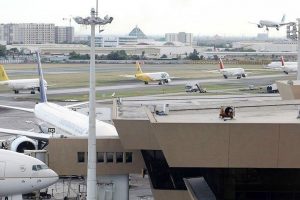By Ashley Erika O. Jose, Reporter
LOCAL airlines are expected to achieve higher growth this year, according to a report by the International Air Transport Association (IATA) projecting sustained earnings for global airlines.
“Airlines continue to shore up their profitability. The expected aggregate net profit of $30.5 billion in 2024 is a great achievement considering the recent deep pandemic losses,” IATA Director General William M. Walsh said in an IATA report dated June 3.
Global airlines are destined for growth this year managing to adapt the turbulence brought by the pandemic, said IATA, a trade association of the world’s airlines.
This comes after IATA revised its profit forecast for 2024. This new projection will depend on the expected record-high revenues for global airlines and the record-high number of global travelers.
In December, IATA reported that it only expected global airlines to post net profits of $25.7 billion.
In its revised projection, IATA said airlines are now expected to hit net profits of $30.5 billion, while total revenues may reach $996 billion this year, driven by the expected surge in the number of global travelers to 4.96 billion.
Air cargo volumes are expected to hit 62 million tons this year, IATA said, adding that passenger revenues are projected to hit $744 billion, 15.2% higher than $646 billion in 2023.
Local airlines continue to see surging demand for passenger and cargo services, First Grade Finance, Inc. Managing Director Astro C. del Castillo said in a Viber message.
“The government’s focus on boosting tourism and the global ‘revenge travel’ trend will further benefit the industry. Additionally, the increasing volume of global and domestic trade will be a positive factor,” he said.
According to preliminary data from the Philippines Statistics Authority, domestic trade in goods in the first quarter grew by 46.7% year on year to P389.42 billion.
By volume, domestic trade increased by 19.7% to 7.73 million tons in the first quarter, up from 6.45 million tons in the same period a year ago.
“Airline companies are on track for sustained growth and increased profitability in the second quarter of 2024 and beyond. The industry is showing a remarkable recovery, and the future looks promising despite lingering challenges,” Seedbox Securities, Inc. equity trader Jayniel Carl S. Manuel said in an e-mail.
For the first quarter, PAL Holdings, Inc., the listed operator of Philippine Airlines, saw its attributable net income decline to P3.6 billion from P4.65 billion, attributed to increased expenses during the period.
For the January to March period, the company’s expenses grew to P39.07 billion, marking a 12.7% increase from P34.68 billion in the previous year.
PAL’s higher expenses were fueled by its flying costs at P21.15 billion, accounting for the majority of its expenses at 54.1% share of its total spending for the period.
For the first quarter, the company recorded a combined revenue of P45.8 billion, which is 8.5% higher than the P42.21-billion top line logged in the corresponding period last year.
“With the expected increase in passenger volumes… and strategic cost management, airline companies are well-positioned to sustain their growth and boost profitability in the upcoming quarters. The industry’s resilience and ability to navigate through economic and geopolitical challenges underscore a positive outlook for 2024 and beyond,” Mr. Manuel said.
According to IATA, Asia-Pacific is expected to account for half of the RPK (revenue passenger kilometers) growth in 2024, driven by recovering domestic markets in China, Japan, and Australia. RPK measures the volume of passengers carried by multiplying the number of revenue-paying passengers by the distance traveled in kilometers.
Philippine Airlines has said that it is planning to relaunch routes to Japan this year to accommodate the increasing demand while also expanding its network.
“Without a doubt, aviation is vital to the ambitions and prosperity of individuals and economies. Strengthening airline profitability and growing financial resilience is important. Profitability enables investments in products to meet the needs of our customers and in the sustainability solutions we will need to achieve net zero carbon emissions by 2050,” IATA said.
Philippine Airlines has allocated $450 million, or more than P25 billion, for this year’s capital expenditures to expand its fleet and meet increasing market demand.
In April, the company said it expects a single-digit growth for 2024 boosted by its capacity expansion.
PAL is scheduled to operate nonstop Manila-Seattle flights three times a week by October. Seattle will be PAL’s sixth destination in the US and its eighth in North America, the airline said.
Meanwhile, Cebu Air, Inc., the operator of Cebu Pacific, posted a P2.24 billion attributable net income, more than double the P1.08 billion last year.
For the first three months, its revenues surged to P25.3 billion, marking an 21.2% increase from P20.88 billion previously.
Fuel price volatility are still going to be the major headwinds for the industry, IATA said, citing that fuel is expected to average $113.8 per barrel representing a total fuel cost of $291 billion or 31% of all operating costs.
“Airline prospects have historically been closely linked to global economic trends. Nonetheless, the sector has been largely resilient in the face of inflation, high interest rates,” IATA said.
“We generally see a sustained profit recovery for airline companies in the second quarter and first half, underpinned by rising passenger volume and average fares,” China Bank Securities Corp. Research Associate Neil Andrew L. Maderaje said in an e-mail.
Mr. Maderaje said the increasing adoption of visa-free entry and electronic visa policies across the region will be an added catalyst supporting international travel demand.
“We also see further improvements in operating capacity as maintenance backlogs continue to ease, and airlines expand their fleets. With respect to costs, stabilizing jet fuel prices should also help support margins,” he added.






